So many people perceive reflexology as foot massage and nothing else. If you are one of these people, then let me enlighten you. You may be reading the article which could change your mind. The next few paragraphs will discuss reflexology and explain the facts about it. If you are looking for information that will clarify the different misconceptions about reflexology, then you are on the right track.
Reflexology is a technique in which a qualified therapist uses pressure applied by their thumb and fingers to points on the hands, feet or even ears. These areas are the reflex points for the body. These reflex points connect to specific areas of the body, and when they are massaged relief from pain, or an imbalance associated with this specific area, is gently removed. When your body system is not working properly, deposits of calcium, minerals, and uric acid may form in the reflex points which eventually hampers the proper circulation of blood. A skilled reflexologist can use massage techniques to break down these deposits and help restore normal functioning.
On another note, studies show that 75% of ailments and disorders are caused by stress. The first thing that you can do to prevent stress-related illnesses is to rest and relax. Here’s where reflexology comes in. Focusing on the reflex points can help your body relax by normalizing your blood flow and calming the nerves, allowing the body to receive the full reflexology benefits.
Your hands and feet have countless nerve endings which are all connected to the different parts of your body. Once you locate and massage the right areas of your feet or hands, you can stimulate the affected areas in your body. Although reflexology may also be applied to the hands, most reflexologists prefer to treat the feet because they are bigger and are more convenient to massage. This is why most people mistake reflexology as just a foot massage.
Hand reflexology, is best for patients who don’t like their feet touched or looked at, and is ideal for people who may complain about hand discomforts such as arthritis or carpal tunnel syndrome. Reflexology applied to the hands may be done anywhere without feeling uneasy and awkward unlike foot reflexology. However, because your hands are sometimes overused, they can become less sensitive and this can sometimes affect the effectiveness of this type of reflexology.
In this time and age, more and more people are changing to alternative treatments such as reflexology and this may be because it promises no side effects. Reflexology may take a few treatments before you feel its effects, but soon you will realise that it is indeed useful and very effective. If you would like to learn where to apply pressure, and to which reflex points, reflexology pictures and charts are available. But if you want an in-depth training in reflexology, attending a reflexology programme or course is highly recommended.
You can try the techniques that you learn on yourself, but reflexology is better when applied by another person because you can relax more which helps the body’s healing energy to be stronger. Plenty of material exists to help you gain knowledge about correct reflexology points and the right pressure, or attend evening classes to help you acquire the information you may need for your home treatments or own personal sessions.
However, if you intend to use your knowledge and training professionally, you can start practicing reflexology on your family and friends. This will serve two purposes; it will introduce them to the advantages of reflexology and help you gain some experience and feedback. Remember that reflexology only becomes effective when done properly, so make sure that you do not attempt to do it without the appropriate investigation and training.
Reflexology has been misunderstood for a long time, but is finally being recognised as not just a foot massage. There is a science behind the treatment, and beneficial results are well documented.




